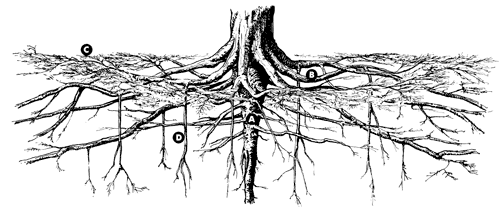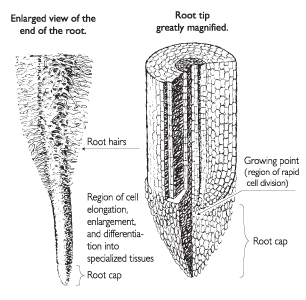The Tree and The Soil

(A) Tap Root — Provides main support of tree and anchors it firmly in the ground. (Not all trees have one)
(B) Lateral Roots — Help support and anchor trunk, may extend far out, beyond crown spread.
(C) Fibrous Roots — Masses of fine feeding roots close to ground surface.
(D) Deeply Descending Roots (‘Sinkers’) — Grow downward from lateral roots.
There is a very close relationship between trees and the soils they grow in. The soil is the storage place for water and the nitrogen and minerals dissolved in water, which are needed by the tree to live and grow. The soil also provides a base for the tree to attach itself firmly in place. The roots, reaching out for water, between the soil particles, serve to anchor the tree as well.
Forest soil and the trees growing on them support a great variety of plants and animals. What kinds and how much of such life there is depend on the type of soil and the kinds of trees and other shrubs growing there—all of which are greatly affected by climate and rainfall. All these elements are closely interrelated, and together they make up what is called the ecosystem or community.
Soils vary considerably in fertility, texture, color, depth, acidity, ability to hold water, and in many other ways, depending on (1) the type of rocks from which the soils were formed; (2) the climate (hot or cold, wet or dry); (3) the trees, bushes, and other plants growing in the soils; (4) the animal and bird life of the areas; (5) whether the soils weathered in place from the bedrock, or were moved to the places they now rest by ice (glaciation), water (streamflow), gravity (sliding), or wind; (6) slope of the land; (7) age, and other factors.
The growing root tips, very small but very numerous, each covered with a protective cap of cells, push into the soil to extend the many-branching root system (see enlarged sketches). Just behind each tip is a dense fuzz of microscopic root hairs growing out all around the rootlet. It is these tiny root hairs which absorb the gallons and gallons of water and dissolved minerals which the tree needs each day during the growing season to live and grow. As the rootlet becomes longer and larger, the older hairs die and are sloughed off; new ones grow closer to the growing tip.
Root System
The root system sketched here is growing in a soil which has no rooting restrictions, such as a shallow watertable, or dense, compact clay layers. Note the big taproot and the many smaller lateral roots extending far on each side—all of which give strong support to the tree and anchor it firmly in place. (Of course, many species of trees do not have taproots.) A few roots descend deeply into the soil from the lateral roots.
Some roots may extend down into the soil very deeply—often 12 feet and sometimes 30 feet or more. Lateral roots may extend from the trunk for long distances also—often 35 feet in each direction and sometimes much more. But most feeding roots are usually in the top 2 or 3 feet of soil. The kind of tree, its age, type of soil, moisture available, competing vegetation, and other factors determine the extent of the root system.
In a typical forest of the temperate zone, where the climate is neither extremely cold nor hot most of the year, nor excessively dry, the soil near the surface is loose, soft, easily crumbled, and usually moist. This natural mellowness is protected and maintained by a covering of fallen leaves, fruits, nuts, twigs, branches, and trunks in various stages of decay—which is called litter and duff. This fall of litter averages over a ton per acre per year in the United States, and is often much more where growth is heavy. It also includes material from animals—feathers, fur, feces, and carcasses of insects, birds, mice, squirrels, etc.
Litter and Humus
The litter in coniferous forests (where evergreens, such as pines, hemlocks, cedars, spruces, and firs grow) is often deeper, taking longer to decompose into humus, than the litter in broadleaved forests. Alders, willows, maples, and cascara are broadleaved trees, which are deciduous (drop their leaves in the fall).
This layer of litter and duff conserves soil moisture by slowing evaporation into the air. The litter also protects the surface soil from erosion by absorbing raindrops as they fall. (When raindrops fall on bare soil, they break down the small crumbly lumps of soil into tiny particles. These particles quickly wash away into streams or clog the pores in the soil, compacting it.) A bare soil more readily allows runoff of rainwater, thus leading to gullies and floods. This happens after forest fires, careless logging, and clearing for homesites.
A loose, porous surface soil (A layer) is important to good plant growth, since it allows air and water to penetrate to where most of the roots are. The surface soil of the typical forest is often fairly dark in color, enriched with the decomposed organic matter (humus) from the litter, and dead roots.
Life of the Soil
The litter and surface soil is the home of many ants, beetles, grubs and other insects, spiders, mites, springtails, millipedes, snails, worms, and small rodents (such as mice and shrews). All these little creatures mix the litter with the soil, and their burrows let rainwater and melting snow drain more quickly into the subsoil.
The surface soil is also teeming with myriads of microscopic life—bacteria and fungi—which decompose the dead plant material (leaves, twigs, and roots), dead animals, insects, etc., making it all part of the soil. Important nutrients are thereby added to the soil. This organic matter is eventually broken down to the basic substances—such as carbon dioxide, water, minerals, and nitrogen—used by trees and other plants.
Each Soil has a Profile

Each soil develops distinct layers (horizons). The layers of a soil form the soil profile. The profile is distinctive for each soil type. Forest soils are usually undisturbed as compared with farm soils that are plowed frequently, so forest soils retain their natural profiles better.
The separate layers of a soil differ from one another in various physical and chemical characteristics. They vary in color, amount of organic (dead plant and animal) material, size and proportions of soil particles, acidity, and in amount of plant nutrients present.
Soil particles are classified as clay, silt, and sand, in order of increasing size. Coarse fragments of rocks such as gravel and stones are frequently present.
The soil layers are partially formed by the downward and sideward percolation of water through the soil. This water carries with it certain dissolved materials, such as lime and very fine clay particles. The water also moves organic matter, iron compounds, and other materials from the surface layer to lower layers.
For more information on soils in your area, refer to the soil survey for the county you live in, or visit the Natural Resource Conservation Service (NRCS) website at soils.usda.gov or www.wa.nrcs.usda.gov